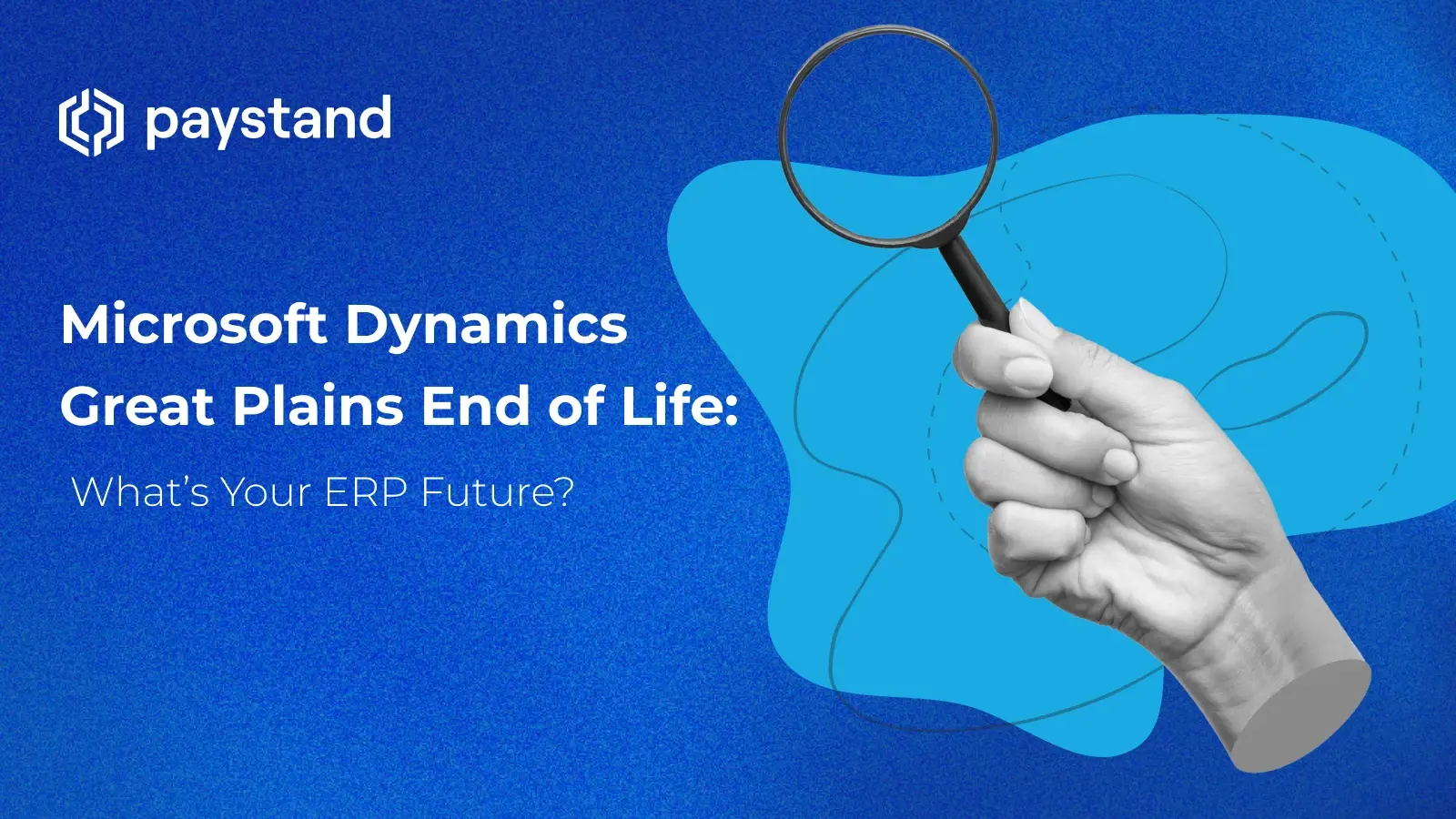Microsoft Dynamics Great Plains End of Life: What’s Your ERP Future?

Table of Contents
- What happens after Microsoft Dynamics GP ends?
- What replaces Microsoft Dynamics Great Plains?
- Making the transition smoothly
- Beyond ERP: a financial revolution
Key Takeaways
- Microsoft is sunsetting Dynamics GP, with support ending by 2031, forcing businesses to rethink legacy ERP strategies before a hard stop.
- Sticking with GP long-term leads to increased risks and costs, as Microsoft shifts to cloud-native solutions like Dynamics 365 Business Central.
- Business Central is an upgrade, providing a secure, flexible, AI-ready ERP platform for modern finance functions like AR automation and real-time data.
- A strategic migration plan is essential; partnering correctly minimizes disruption, modernizes workflows, and empowers teams.
- Paystand transforms ERP payments in Business Central, eliminating fees and manual processes through a blockchain network designed for the future of finance.
Microsoft Dynamics Great Plains (GP) has served as a key ERP solution for finance teams for decades. However, with the shift away from on-prem systems and perpetual licenses, its time is ending. Microsoft has announced the end of support for Dynamics GP, prompting customers to reconsider their financial operations' future.
If your business uses GP 2018 R2 or other versions of Dynamics GP, you likely know that some security patches and service packs are available until September 30, 2029, with select updates until April 30, 2031. After that, lifecycle support ends, and there will be no more technical support, regulatory updates, or product enhancements. It’s a hard stop.
The sunset of Great Plains marks a shift to a future-ready ERP solution that facilitates AR automation, streamlines B2B payments, and integrates with an open financial ecosystem. The real question isn’t, “What replaces Great Plains?” but: Are you ready to lead your organization into the next era of digital finance?
What Happens After Microsoft Dynamics GP Ends?
The short answer: You’ll be on your own. After December 31, 2029, Microsoft will provide no continuous support for Dynamics GP, only limited security updates. Businesses using GP past this date will face increased security risks, limited integration, and rising operational costs due to outdated infrastructure.
As Microsoft focuses on its cloud ERP platform, Dynamics 365 Business Central, GP is no longer part of its roadmap. This aligns with the industry trend away from perpetual licenses and on-prem hosting toward agile, SaaS platforms that support real-time data and automated updates.
If your ERP strategy relies on Great Plains, start planning your transition. Clinging to outdated tools poses a competitive liability.
What Replaces Microsoft Dynamics Great Plains?
Microsoft has positioned Dynamics 365 Business Central as the evolution for GP customers. Business Central is a cloud-native ERP solution that scales with growing companies and supports ERP payments and supply chain management. It offers an integrated, flexible, and secure experience, with regular updates, feature enhancements, and support for modern finance tools like AR automation and AI-driven forecasting.
Migrating from Great Plains to Business Central doesn’t mean starting over; it means upgrading your ERP mindset. You’re not just replacing software; you’re repositioning your business for innovation and resilience.
Making the Transition Smoothly
Migrating from Great Plains can be daunting, but it doesn’t have to be. Partnering with a Microsoft expert in GP and Business Central is crucial to minimizing disruption. They can guide your data migration, assist with process re-mapping, and ensure compliance with standards.
For a successful migration:
-
Assess your current GP environment: What features do you rely on? What integrations are critical?
-
Identify key opportunities: How can Business Central streamline your operations?
-
Choose the right partner: Look for proven experience with ERP migrations and a strong support model.
-
Train your team: Empower users to take advantage of new features, especially those related to automated workflows, ERP payments, and data analytics.
A well-planned migration protects your business from the risks of outdated software and sets the stage for exponential growth.
Beyond ERP: A Financial Revolution
The end of Great Plains reflects a larger issue: the collapse of outdated financial systems. Manual processes, high transaction fees, and lack of transparency hinder business progress.
That’s where Paystand enters the conversation.
Paystand reimagines ERP payments with a decentralized, blockchain-based network integrated with Microsoft Dynamics 365 Business Central. Paystand offers a decentralized, B2B payment network that eliminates transaction fees, automates accounts receivable, and accelerates cash flow without relying on banks or card networks.
Instead of patching up yesterday’s ERP, Paystand invites you into the financial future:
- No transaction fees; flat-fee subscription model
- Automated cash cycle via AR workflows
- Blockchain payment records eliminate disputes.
- Zero-touch reconciliation in Business Central
- Support for B2B payments, self-service portals, and real-time tracking
It’s not just efficiency; it’s transformation. At Paystand, we believe money should move freely like data, unbound by archaic systems. Using smart contracts, AI, and blockchain, we’re creating a new financial system that’s open, automated, and fee-less.
If you’re on Great Plains, ask: Why cling to a ’90s system when finance's future unfolds? ERP systems should enable leadership, not just survival. The time to modernize is waning, but you still have time to switch to a scalable, automated, and cost-efficient solution.
Discover how Paystand’s integration with Microsoft Dynamics 365 Business Central redefines ERP payments through automation, blockchain, and no transaction fees, guiding businesses to move beyond outdated financial infrastructure.





